back to the Campo Marzio
Stephen Lauf 2001.09.08 16:50
Hello John [Wilton-Ely],
...getting back to the two states of the Ichnographia, here are some further thoughts and questions:
. . . . . .
2. I think the circus delineations of the second state (which are all virtually identical to each other) are in fact delineations based on the Circus of Maxentius (rather than the Circus Maximus). This is somewhat significant in that (according to my research and interpretation of the Ichnographia as a double narrative relating Rome's inversion from pagan city to Christian city) Maxentius is exactly the ruler of Rome immediately prior to Constantine's Christian efforts.
can you spot the differences?
Stephen Lauf 2003.11.17 20:22
Each of the six circuses delineated within the Ichnographia (large plan) were completely changed in design configuration to the perfected configuration that is found in the real Circus of Maxentius (306-312 AD). Piranesi's own circus designs (i.e., with the openings) in the first state are very stylized versions of a circus plan.
Piranesi spent a lot of time surveying and measuring Roman ruins, and perhaps he himself measured the Circus of Maxentius, found the refinement of its plan (apparently the Circus of Maxentius is the most refined arena layout for chariot racing), and thought to change his circus designs after some versions of the Ichnographia were already published (--but here I'm only making a possible guess).
Re: NeoClassical Chili
Stephen Lauf 2005.07.09 15:34
Krautheimer published an essay--"Mensa-Coemeterium-Martyrium" 1960--where he earnestly speculates about the very real possibility that the early "Constantinian" basilicas (aside from St. John Lateran and St. Peter's Vatican) acted as covered graveyards where funeral banquets were held. He also noted how the shape of these basilicas was circus-like. When I read this essay (early 2005), I immediately though of the connection to the 'munus' ritual as related by Tertullian. And, after finding out more about the Mausoleum of Romulus/Circus of Maxentius complex (also early 2005), the "pieces" quickly fell together, particularly the connection of Eutropia to all this.
The Circus of Maxentius has been an unanswered question in my mind for a few years now, and now I think I know why Piranesi 'secretly' printed two different versions of the Ichnographia Campus Martius--the Circus of Maxentius is the 'key' to the inversion of the pagan Roman Circus into the Early Christian 'basilica.' Piranesi, in Le Antichitą Romane Vol. 2 (which predates the Campo Marzio publication by four years or so), delineated a "reconstruction" of the Basilica of St. Agnes
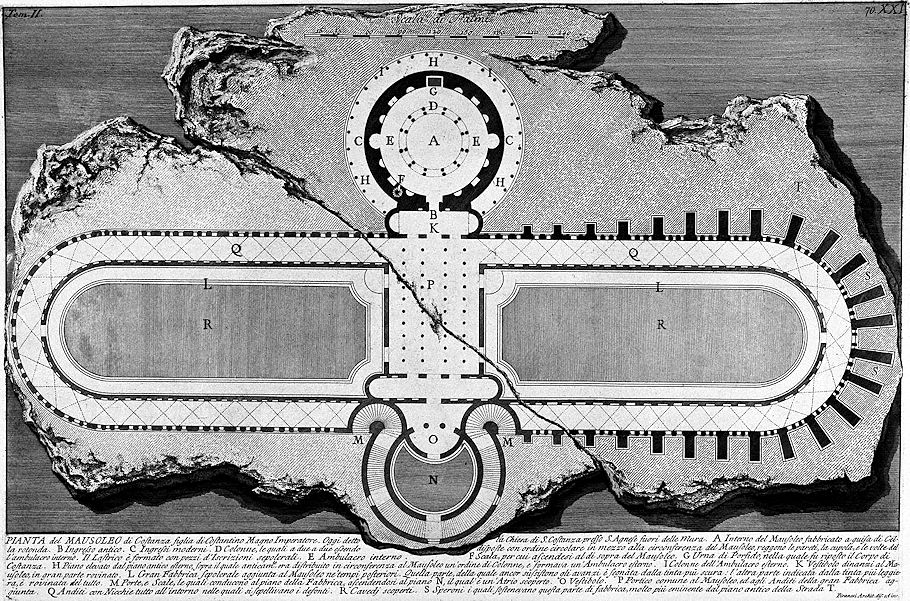
13101702.db
Stephen Lauf 2013.10.17
CAD database: Circus and Tomb of Hadrian, Mausoleum of Romulus and Circus of Maxentius, Basilica of Sts. Peter and Marcellius and Mausoleum of Helena, Basilica of St. Agnes and Mausoleum of Constantina, plans at the same scale oriented true north
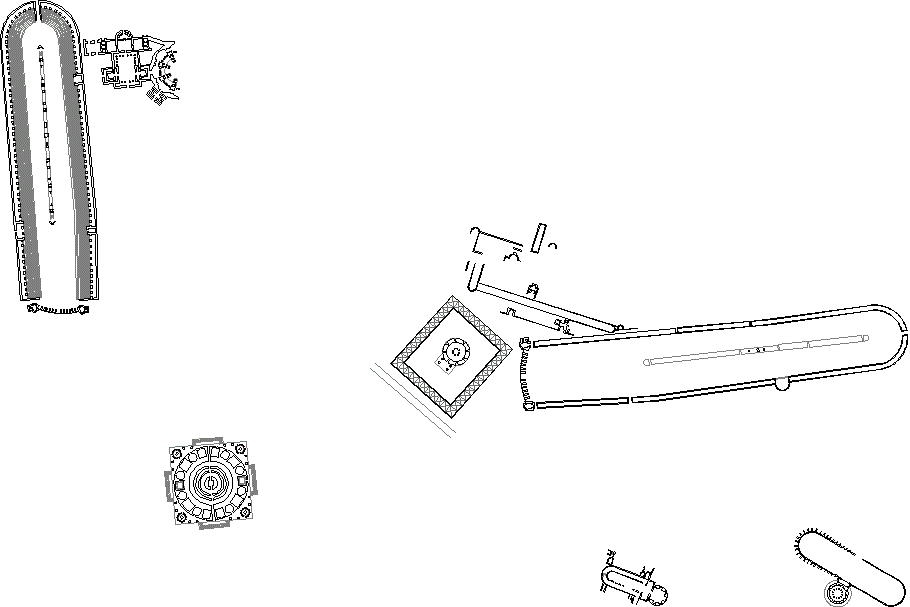
2014.01.31
My first encounter with Pianta degli avanzi di un 'antica Villa, sue Fabbriche, e Circo volgarmente detto di Caracalla fuori di porta S. Sebastiano occurred while looking through the commons.wikimedia collection of images from Piranesi's Le Antichitą Romane Vol. 1 and Vol. 2.

Virtually everything about this print seemed wrong, except for the site plan layout of the delineated buildings. The print itself, as far as I knew, was not part of Le Antichitą Romane, and the overall design of the print looked like an amateur's work done in the style of Piranesi. Plus, the Circus of Maxentius is mislabeled as the Circus of Caracalla. A nice and correct though unsigned and undated site plan, but otherwise a misplaced item that has nothing to do with Piranesi. Or does it? Who knows?
circa 2018
I find that Pianta degli avanzi di un 'antica Villa, sue Fabbriche, e Circo volgarmente detto di Caracalla fuori di porta S. Sebastiano is indeed part of Le Antichitą Romane Vol 1, at least within Le Antichitą Romane Vol 1 at Universitätsbibliothek Heidelberg.
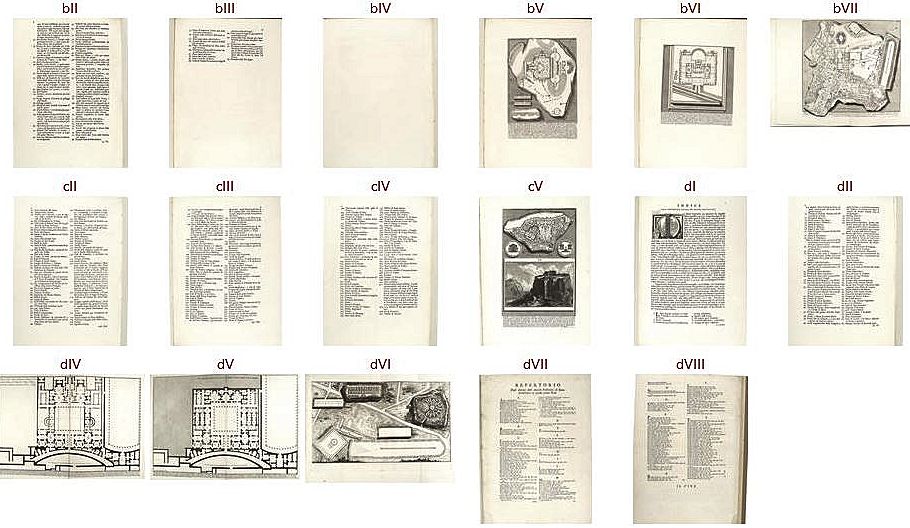

Pianta degli avanzi di un 'antica Villa, sue Fabbriche, e Circo volgarmente detto di Caracalla fuori di porta S. Sebastiano
Plan of the remains of an ancient Villa, its Site[?], and Circus commonly known as Caracalla outside Porta S. Sebastiano
Universitätsbibliothek Heidelberg
2020.03.01
I find and collect large scanned images of Pianta degli avanzi di un 'antica Villa, sue Fabbriche, e Circo volgarmente detto di Caracalla fuori di porta S. Sebastiano within the Getty Research Institute copy of Le Antichitą Romane Vol 1 available at archive.org.
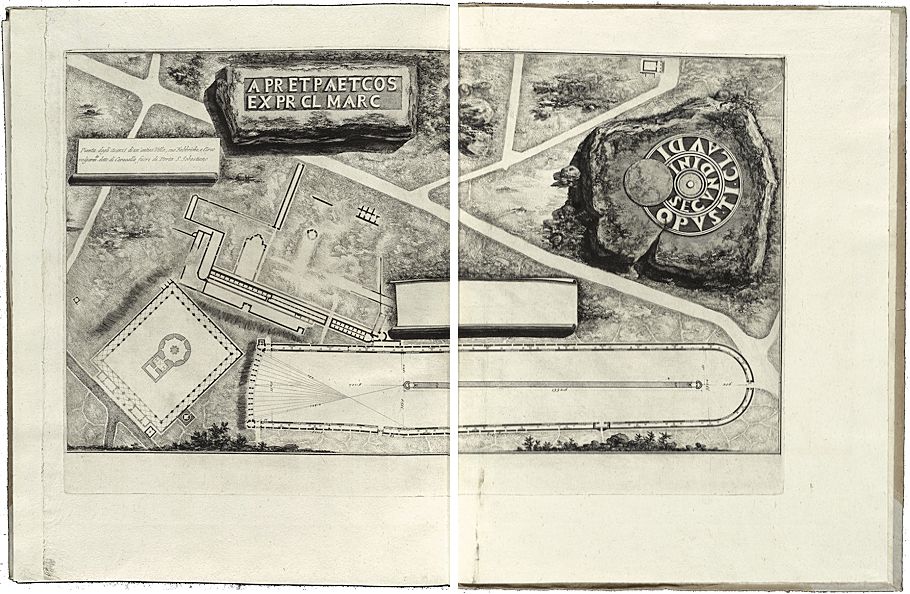
Pianta degli avanzi di un 'antica Villa, sue Fabbriche, e Circo volgarmente detto di Caracalla fuori di porta S. Sebastiano
Plan of the remains of an ancient Villa, its Site[?], and Circus commonly known as Caracalla outside Porta S. Sebastiano
Getty Research Institute
2021.08.19
According to Henri Focillon (1918):
In some copies of [Le Antichitą Romane Vol 1] the second edition, after 1787, follow 3 plates.
1. Plan of the upper floor of part of the Palace of the Caesars ...
2. Plan of the lower floor of part of the Palace of the Caesars ...
Both signed Francesco Piranesi and dated 1787.
3. Plan of the leftovers from an ancient villa ... outside St. Sebastiano gate. -- not signed,
meaning, some copies of the second edition of Giovanni Battista Piranesi's Le Antichitą Romane vol. 1 have been appended with three additional plates--two plans of part of the Palace of the Caesars on the Palatine Hill, signed and dated Francesco Piranesi 1787, and a site plan of the Maxentian complex along the Appian Way, comprising a mausoleum, a villa/dining hall and a circus, which is not signed. Although the images of each added plate are more or less self-explanatory, the reason as to why these particular images have been added to the first volume of Le Antichitą Romane is nowhere provided.
2022.05.29
Work on "The Discovery of Piranesi's Final Project" begins with combining the two large scanned half images of Pianta degli avanzi di un 'antica Villa, sue Fabbriche, e Circo volgarmente detto di Caracalla fuori di porta S. Sebastiano from the Getty Research Institute copy of Le Antichitą Romane Vol 1 into one large image.
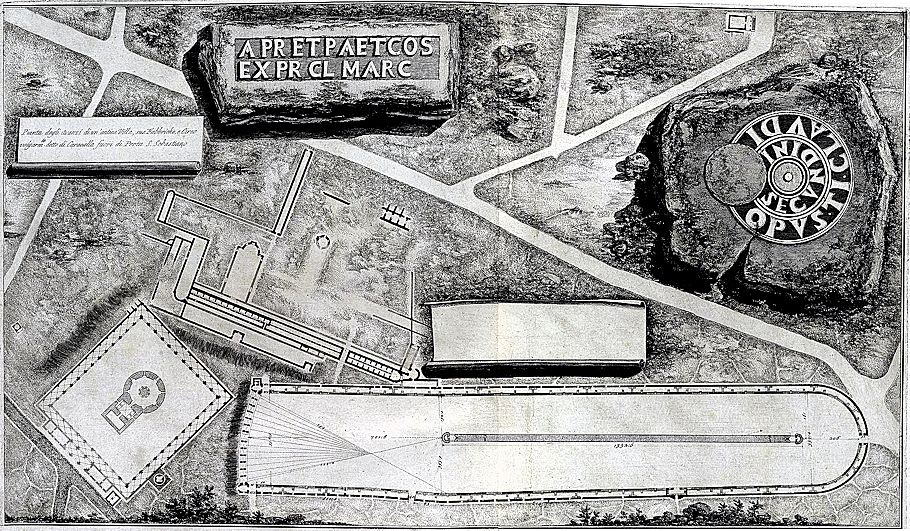
Upon completion, I compare the new large image with the next largest scanned image of Pianta degli avanzi di un 'antica Villa... from Universitätsbibliothek Heidelberg. It's immediately noticed that the circus plan within the Getty Research Institute image is dimensioned, whereas the circus plan within the Universitätsbibliothek Heidelberg image is not dimensioned. The last thing I expected was to again, for a third time, discover a Piranesi print of plans that exists in two distinct versions. And yes, I'm now also convinced it was Giovanni Battista Piranesi who etched the cooper plate from which all copies of Pianta degli avanzi di un 'antica Villa, sue Fabbriche, e Circo volgarmente detto di Caracalla fuori di porta S. Sebastiano were printed.
|